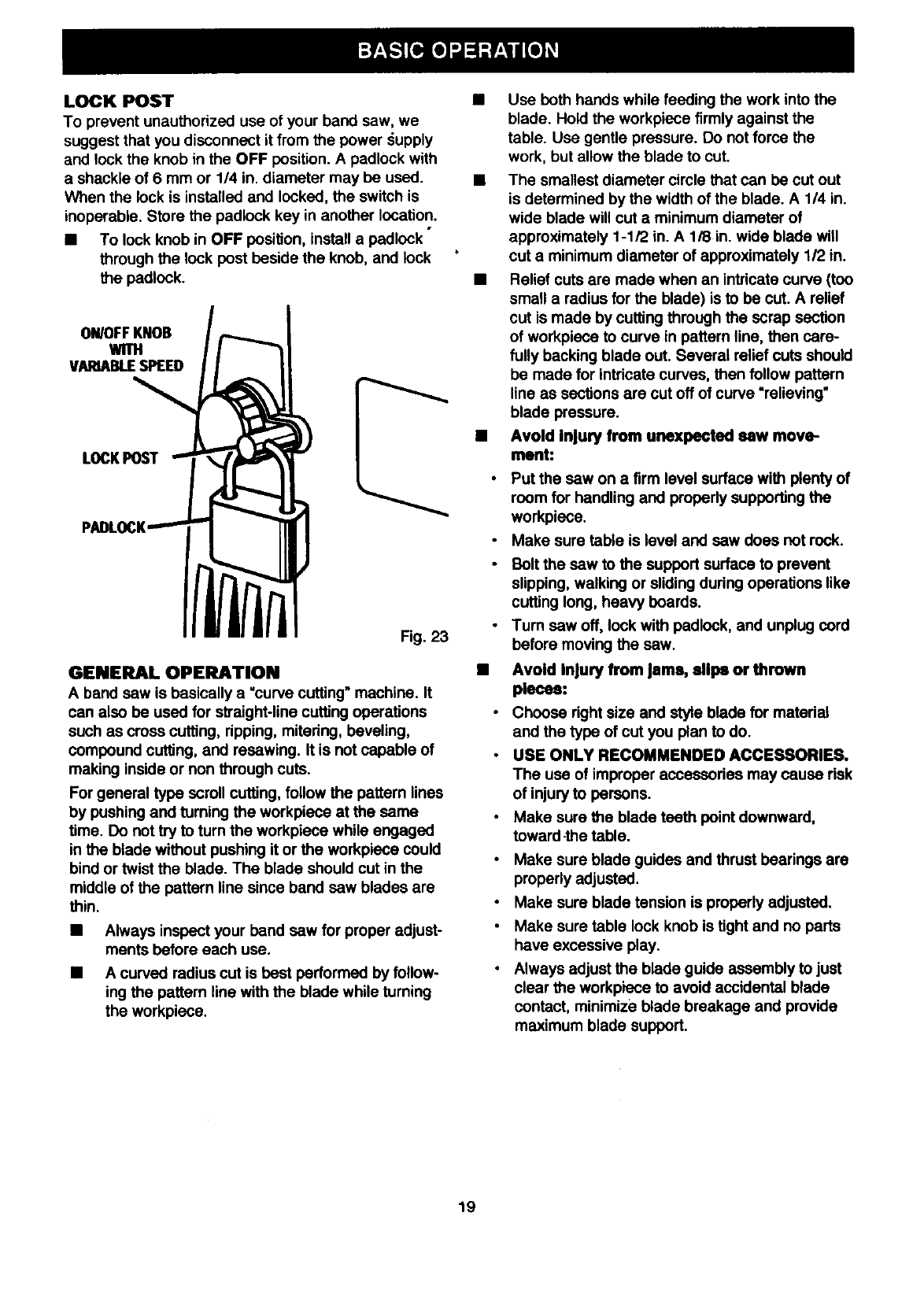
LOCK POST •
To preventunauthorizeduseofyourbandsaw,we
suggestthatyoudisconnectit fromthe power dupply
and lock the knob in the OFF position. A padlock with
a shackle of 6 mm or 114 in. diameter may be used. •
When the lock is installed and locked, the switch is
inoperable. Store the padlock key in another location.
• To lock knob in OFF position, install a padlock
through the lock post beside the knob, and lock
the padlock. •
ON/OFFKNOB
WITH
VARIABLESPEED
LOCKPOST
Fig, 2:3
GENERAL OPERATION
A band saw is basically a "curve cutting" machine. It
can also be used for straight-line cuffing operations
such as cross cutting, ripping, mitedng, beveling,
compound cuffing, and resawing. It is not capable of
making inside or non through cuts.
For general type scroll cuffing, follow the pattern lines
by pushing and turning the workplece at the same
time. Do not try to turn the workpiece while engaged
in the blade without pushing it or the workpiece could
bind or twist the blade. The blade should cut in the
middle of the pattern line since band saw blades are
thin.
• Always inspect your band saw for proper adjust-
ments before each use.
• A curved radius cut is best performed by follow-
ing the pattern line with the blade while turning
the workpiece.
Use both hands while feeding the work into the
blade. Hold the workplece firmly against the
table. Usa gentle pressure. Do not force the
work, but allow the blade to cut.
The smallest diameter circle that can be cut out
is determined by the width of the blade. A 114 in.
wide blade will cut a minimum diameter of
approximately 1-1/2 in. A 1/8 in. wide blade will
cut a minimum diameter of approximately 1/2 in.
Relief cuts are made when an intricate curve (too
small a radius for the blade) is to be cut. A relief
cut is made by cutting through the scrap section
of workplsce to curve in pattern line, then care-
fully backing blade out. Several relief cuts should
be made for intricate curves, then follow pattern
line as sections are cut off of curve "relieving"
blade pressure.
Avoid Injury from unexpected uw move-
ment:
Put the saw on a firm level surface with plenty of
room for handling and properly supporting the
workpiece.
Make sure table is level and saw does not rock.
Bolt the saw to the support surface to prevent
slipping, walking or sliding during operations like
cutting long, heavy boards.
Turn saw off, lock with padlock, and unplug cord
before moving the saw.
Avoid Injury from Jams, 8111_or thrown
pieces:
Choose right size and style blade for material
and the type of cut you plan to do.
USE ONLY RECOMMENDED ACCESSORIES,
The use of improper accessories may cause risk
of injury to persons.
Make sure the blade teeth point downward,
toward -thetable.
Make sure blade guides and thrust bearings are
properly adjusted.
Make sure blade tension is properly adjusted.
Make sure table lock knob is tight and no parts
have excessive play.
Always adjust the blade guide assembly to just
clear the workpiece to avoid accidental blade
contact, minimize blade breakage and provide
maximum blade support.
19


















